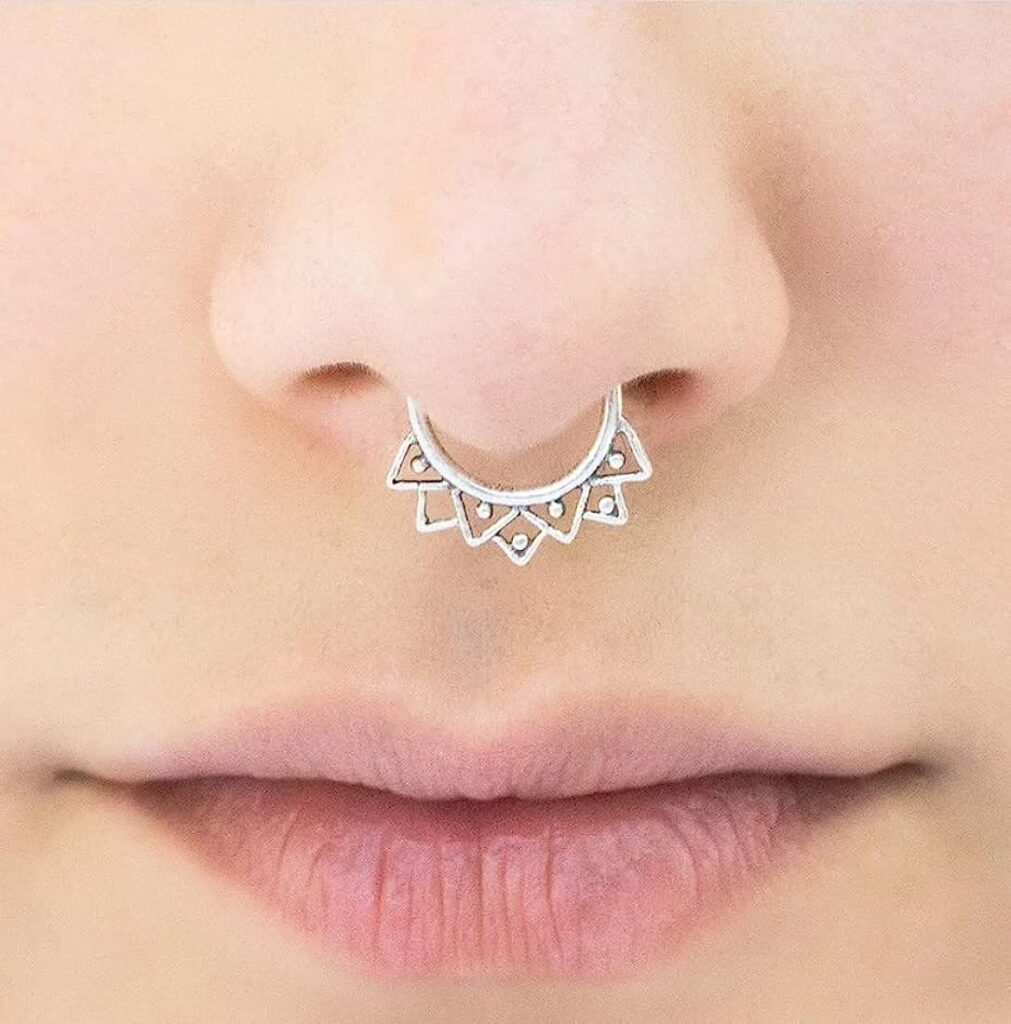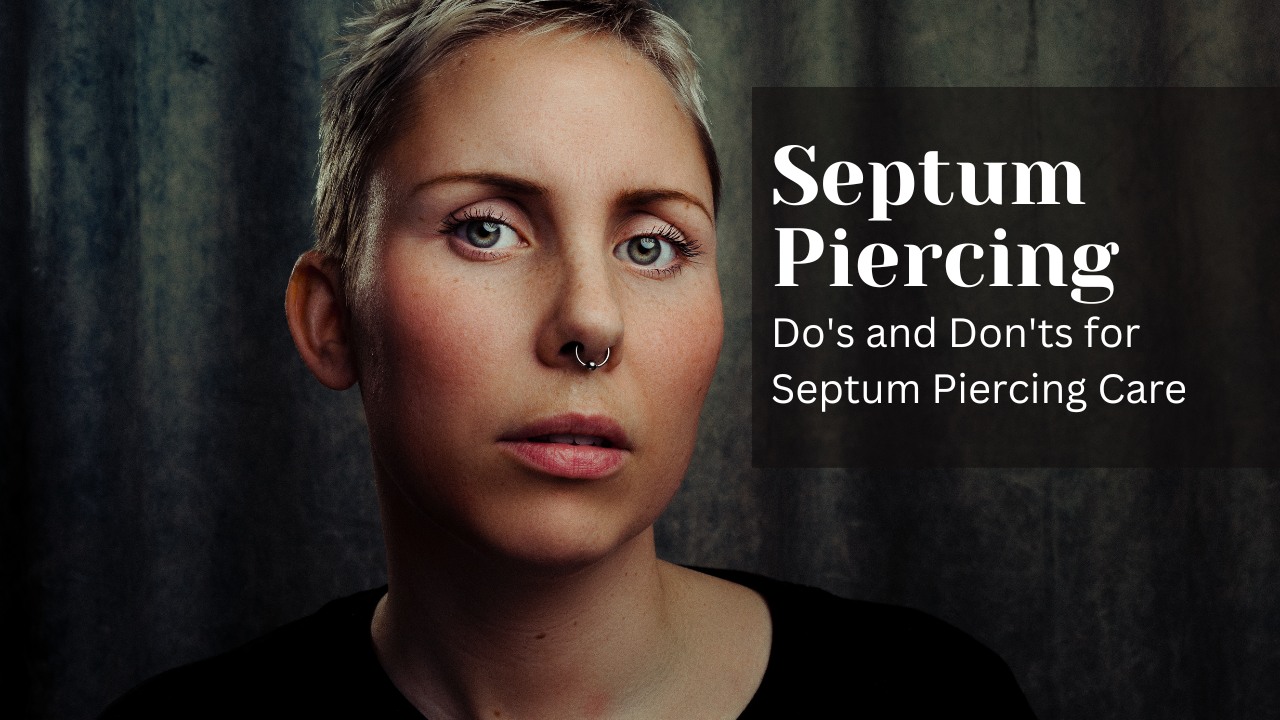Proper care of a septum piercing is essential to ensure proper healing, reduce complications, and maintain the overall health of the piercing. Here are some reasons why proper care is important:
- Healing process: Septum piercings, like any other body piercing, require time to heal. By following proper care guidelines, you can promote a fast and smooth healing process. This includes keeping the piercing clean and free of irritation that can delay healing.
- Infection prevention: One of the primary concerns with any piercing is the risk of infection. By cleaning your piercing regularly and following proper care instructions, you can reduce your risk of infection. Cleaning helps remove bacteria and dirt that can build up around the piercing, reducing the chance of infection.
- Avoiding Complications: Improper care can lead to complications such as migration, rejection or scarring. For example, not cleaning the piercing or using harsh cleaning agents can irritate the delicate tissues and increase the chance of complications. Proper care minimizes the chances of these problems and helps maintain the aesthetic appearance of the piercing.
- Minimizing pain and discomfort: Septum piercings can be sensitive during the healing process. Proper care helps reduce the pain, swelling, and discomfort associated with piercings. Following aftercare guidelines can reduce these symptoms and promote a more comfortable treatment experience.
- Long-Term Piercing Health: Taking care of your septum piercing during the healing phase sets the foundation for its long-term health. By maintaining good hygiene practices and avoiding unnecessary trauma or irritation, you can help ensure that the piercing remains healthy and problem-free over time.
To properly care for a septum piercing, it is important to follow the care instructions provided by your piercer. These instructions usually include cleaning the piercing site with saline solution or mild soap, avoiding touching the piercing site with unwashed hands, and refraining from changing or removing jewelry until the piercing is completely healed.
Remember to consult a professional piercer or healthcare provider if you experience severe pain, excessive swelling, redness, or signs of infection, as these may require medical attention.
Overview
Certainly! Here’s a brief overview of the dos and don’ts for proper care of septum piercings:

Do’s
- Clean the piercing
- Wash your hands
- Dry gently
- Be cautious with clothing and accessories
- Be mindful during activities
Don’ts
- Don’t touch unnecessarily
- Avoid harsh cleaning products
- Say no to swimming pools, hot tubs, and lakes
- Don’t remove the jewelry prematurely
- Avoid sharing personal items
Keep in mind that these are only general recommendations; you must strictly go by the aftercare rules that your piercer gives you. See a trained piercer or a medical professional for advice if you have any worries or queries about your septum piercing.


Do’s of Septum Piercing Care
A. Cleaning and hygiene practices
Cleanliness and hygiene practices are important for proper care of a septum piercing. Here are some guidelines to follow:
- Clean your septum piercing regularly: Clean your septum piercing twice a day, preferably morning and evening, using a saline solution or a mild, fragrance-free soap. A saline solution can be prepared by dissolving non-iodized sea salt in warm distilled water (1/4 teaspoon of salt per 8 ounces of water).
- Wash your hands before cleaning: Before touching your piercing or doing any cleaning, be sure to wash your hands thoroughly with soap and water to reduce the risk of introducing bacteria to the piercing site.
- Soak the piercing: To clean your septum piercing, soak a clean cotton ball or sterile gauze pad in saline solution and gently apply it to the piercing. Let the solution sit on the piercing for a few minutes to help loosen any built-up debris or crust.
- Gently remove debris: After soaking, use a clean cotton swab or your fingers (if they are clean) to gently remove any soft debris or crust around the hole. Avoid applying excessive pressure or force, as this may cause burns or damage to the healing tissue.
- Wash thoroughly: After cleaning, wash the piercing with clean, warm water to remove any residue from the saline solution or soap. Be sure to remove all traces of cleaning agents, as they can cause dryness and irritation.
- Pat dry gently: After washing, gently pat dry the area around the piercing with a clean, disposable paper towel or a lint-free cloth. Avoid using towels or clothing that may release fibers or contain bacteria.
- Avoid unnecessary touching: Try to avoid unnecessary touching of the piercing, as this can introduce bacteria and prolong the healing process. Only touch the piercing with clean hands when absolutely necessary, such as during the cleaning process.
- Avoid excessive cleaning: Although cleaning is necessary, excessive cleaning can inhibit the natural healing process. Follow the recommended cleaning routine twice a day and avoid excessive rubbing or harsh cleaning agents.
B. Handling the piercing with care
Avoiding touching or twisting your septum piercing excessively is important for proper healing and reducing the risk of complications. Here’s why you should avoid it and how to prevent unnecessary contact:
- Interference with the healing process: Touching or twisting the piercing excessively can interfere with the healing process. The constant motion and friction can irritate the delicate tissues, causing increased swelling, redness, and longer healing time.
- Entry of bacteria: Touching the piercing with unclean hands increases the risk of introducing bacteria or other contaminants to the piercing site. This can lead to infection or other complications.
- Trauma and irritation: Twisting or playing with jewelry can cause trauma to the piercing, causing discomfort, swelling, and potential damage to the healing tissue. This can also increase the chances of transfer or rejection of jewellery.
To prevent excessive touching or jerking:
- Wash hands before any contact: Always wash your hands thoroughly with soap and water before touching your septum piercing or adjusting jewelry. This helps reduce the entry of bacteria.
- Be careful with jewelry: Avoid unnecessarily moving or twisting the jewelry in your septum piercing. Once the initial healing phase is over, it is generally recommended to leave the jewelry in place without repeated adjustments.
- Avoid playing or fiddling with jewelry: Resist the temptation to touch, move, or play with the jewelry in your septum piercing. Keep in mind that the more you touch or manipulate it, the greater the risk of irritation and complications.
- Be vigilant during daily activities: When engaging in activities that may involve contact with the pierced area, such as washing your face or brushing your hair, be careful to avoid unnecessary contact with the pierced area. Take special care that the jewelery does not get stuck with clothes or towels.
By minimizing excessive touching or twisting, you allow your septum piercing to heal properly and reduce your risk of complications. Remember to consult your piercer or health care professional if you experience any unusual pain, swelling, discharge, or signs of infection.
C. Following aftercare instructions from your piercer
You may monitor the healing of your septum piercing and be prepared for it by being aware of the schedule and stages of the procedure. Here is a broad breakdown of the stages of recovery, notwithstanding the fact that individual healing times can vary:
- Early healing (1-2 weeks): Initial healing takes place in the first phase. The vicinity of the piercing may be sore, sensitive, and swollen. Immediately following the piercing, you can suffer mild blood and very minor redness. To avoid infection at this time, it’s crucial to adhere to the right cleaning and maintenance procedures.
- Early healing (2-4 weeks): In this phase, the swelling and tenderness should gradually subside. The initial redness may begin to fade, and the piercing site begins to settle. It is important to continue with regular cleaning and follow the care guidelines.
- Mid-stage healing (4-8 weeks): During this stage, the piercing should start to feel more comfortable. Swelling should be minimal, and redness should continue to subside. However, healing is not complete, and the piercing may still be somewhat sensitive. It is important to avoid unnecessary trauma or touching during this period.
- Late healing (8 weeks – 6 months): This is the final stage of healing, where the piercing is fully mature. The tenderness should be significantly less, and the piercing should feel more stable. The overall appearance should improve, and any residual redness should fade. However, it is important to continue following proper aftercare practices until the piercing has completely healed.
It is important to note that healing time can vary from person to person and depends on factors such as individual healing ability, after-care methods, and overall health. It is recommended to consult with your piercer for personalized guidance and to determine the progression of your specific septum piercing.
It is crucial to exercise patience and refrain from actions that can irritate the wound or hinder healing, such as excessive touching, twisting, or removing jewelry too soon. See your piercer or a medical practitioner right away if you experience excruciating pain, persistent swelling, profuse discharge, or evidence of infection.

Don’ts of Septum Piercing Care
A. Touching or manipulating the piercing excessively
Bacteria entering or causing irritation in a septum piercing can lead to various risks and complications. Here are some possible results:
- Infection: Bacteria getting into the piercing site can lead to infection. Signs of infection may include increased redness, swelling, warmth, pain, and the presence of pus or discharge. Infections require immediate medical attention, as they can get worse if left untreated and may require antibiotics.
- Delays healing: Excessive touching, twisting or piercing can introduce bacteria into the healing process. This can lead to prolonged swelling, increased tenderness, and delayed healing. Proper care and avoiding unnecessary contact can make the healing process easier.
- Irritation and Discomfort: Constantly touching or twisting the jewelry can irritate the surrounding tissue. This can lead to increased sensitivity, redness and discomfort. This can prolong healing time and increase the risk of complications such as hypertrophic scarring or keloids.
- Allergic reactions: Some people may be allergic to certain metals used in jewellery, such as nickel. Excessive exposure or prolonged exposure to an allergen can result in an allergic reaction, resulting in itching, redness, swelling, and discomfort. It is important to choose high quality jewelry made from materials suitable for your skin to reduce the risk of allergic reactions.
- Trauma and damage: Excessive manipulation or trauma to the piercing can damage the healing tissue, leading to complications such as migration, rejection, or scarring. Avoiding unnecessary contact helps protect the integrity of the piercing and reduces the risk of long-term damage.
B. Using improper cleaning solutions or techniques
It’s crucial to avoid common mistakes when taking care of a septum piercing because they can impede the healing process and raise the possibility of complications. The following errors should be avoided:
- Touching the piercing with dirty hands: Before touching your septum piercing or doing any cleaning or maintenance, always thoroughly wash your hands with soap and water. Using unhygienic hands to touch the piercing increases the chance of infection and introduces bacteria.
- Excessive cleaning or use of harsh products: While proper cleaning is important, excessive cleaning of the piercing or use of harsh cleaning agents can inhibit the natural healing process. Follow the recommended cleaning routine provided by your piercer and avoid using products such as alcohol, hydrogen peroxide, or ointments, as they can be drying and irritating.
- Removing or replacing jewelry too early: It is essential to leave the initial jewelry in place until the hole has completely healed. Removing or replacing jewelry too quickly can inhibit the healing process, cause irritation, and increase the risk of infection. Consult your piercer before considering any change in jewellery.
- Prolonged twisting or playing with jewelry: It can traumatize the healing tissue, resulting in scarring, lengthening the healing process, and raising the possibility of problems. Avoid moving the jewelry too much or touching it excessively.
- Using inappropriate jewelry or materials of low quality: Use jewelry of the highest caliber created from substances safe for body piercings, such as surgical-grade stainless steel, titanium, or gold. Use caution when wearing inexpensive or poor-quality jewelry that could irritate or trigger allergies.
C. Ignoring signs of infection or complications
While caring for a septum piercing, it’s crucial to identify symptoms right away and take appropriate action. Being aware of potential issues and quick to act when they are detected might assist avoid complications and advance effective treatment. Here’s how to recognize the signs and properly treat them:
- Swelling and redness: In the first few weeks following a septum piercing, some swelling and redness are typical. It could be an indication of an infection or other complications if the redness and swelling worsen over time or if they are accompanied by excruciating pain, tenderness, or warmth near the piercing site. For an assessment and the best course of action, speak with your piercer or a health care provider.
- Severe discomfort or pain: While some minor discomfort is normal during the initial healing process, persistent or escalating pain may be a sign of trouble. See a professional if the pain has intensified, is throbbing, or is not getting better over time. Avoiding infections, irritants, and other issues that might necessitate treatment is crucial.
- Discharge or pus: During the course of a septum piercing’s normal healing process, lymph fluid—a clear or faintly white discharge—may be present. On the other hand, profuse or offensive-smelling discharge, pus, or a greenish-yellow hue can indicate an infection. For an assessment and the best course of therapy, speak with a healthcare practitioner.
- Bleeding that doesn’t stop: Little bleeding is frequent right after a septum piercing. But, bleeding that persists or that suddenly worsens could be a sign of something serious. If the bleeding does not stop after applying light pressure with a clean cloth or sterile gauze, seek professional assistance.
- Signs of Allergy or Hypersensitivity: Excessive itching, redness, rash, or swelling that lasts longer than the normal healing process may be an indication of an allergic reaction or hypersensitivity to the material used to make the jewelry. To find out the reason and go over jewelry possibilities, speak with your piercer or a medical expert.
- Changes in the appearance or fit of the jewelry: Pay attention to any unusual changes in the appearance of your septum piercing, such as excessive bruising, the jewelry digging into the skin, or the jewelry feeling too tight or loose. These changes may indicate complications such as migration or rejection. Seek professional advice if you notice any significant change in the piercing.
If you experience any of these symptoms or are concerned about your septum piercing, it is important to contact your piercer or health care professional. They can assess the situation, provide guidance and recommend appropriate treatment if necessary. Getting prompt attention and early attention to symptoms can help prevent further complications and ensure proper care for your septum piercing.
FAQs: Frequently Asked Questions
Q1: How often should I clean my septum piercing?
Answer: It is recommended to clean your septum piercing twice a day. However, it is important to follow the aftercare instructions given by your piercer, as they may have specific guidelines depending on the progress of your piercing and healing.
Q2: What type of cleaning solution should I use?
Answer: Saline solution or a mixture of non-iodized sea salt and warm water is usually recommended for cleaning septum piercings. Avoid using alcohol-based products or harsh chemicals, as they can irritate the piercing and slow down the healing process.
Q3: Can I touch or bend my septum piercing during the healing period?
Answer: It is best to avoid touching or twisting your septum piercing as much as possible. Excessive touching can introduce bacteria and increase the risk of infection. If you need to adjust jewellery, always wash your hands thoroughly before doing so.
Q4: What should I do if my septum piercing shows signs of infection?
Answer: If you notice signs of infection like excessive swelling, redness, severe pain or discharge with unusual odor, it is important to seek professional advice. Your piercer or healthcare provider can assess the situation and provide appropriate treatment.
Q5: Can I change my septum jewelry during the healing process?
Answer: It is generally recommended to wait until your septum piercing is completely healed before changing jewellery. Healing time varies, but it usually takes about 6-8 weeks. Changing jewelry too early can hinder the healing process and increase the risk of complications.
Question 6: Should I remove my septum piercing for activities such as swimming or sports?
Answer: It is generally advised to avoid submerging your fresh septum piercing in water such as swimming pools or hot tubs until it is completely healed. Additionally, for activities that involve physical contact or risk of injury, it is recommended to cover the piercing with a soft material or remove jewelry temporarily to prevent damage.
Q7: How can I prevent my septum piercing from showing on clothing or accessories?
Answer: Be mindful of the jewelery you wear and the clothes and accessories you choose. Avoid wearing clothing with tight necklines or collars that could pull or pull on jewelry. Additionally, remove or adjust jewelry that may pose a risk of entanglement or entanglement in objects during physical activities.
Q8: Is it normal for my septum piercing to feel sore or have some swelling?
Answer: Mild pain and swelling are common during the initial healing period of septum piercing. However, if the pain or swelling is severe or is accompanied by other associated symptoms, it is recommended to consult your piercer or health care professional for further evaluation.
Q9: Can I use makeup or skin care products near my septum piercing?
Answer: It is best to avoid applying makeup or skin care products directly on or around your septum piercing during the healing process. These products may irritate or introduce bacteria to the piercing site, potentially causing complications. Once the piercing is fully healed, you can resume using such products, making sure they don’t come in direct contact with the piercing.
Q10: What should I do if I have additional questions or concerns about my septum piercing care?
Answer: If you have any specific questions or concerns regarding the care of your septum piercing, you are advised to contact your piercer. They are the best resource for providing personalized advice based on your individual circumstances. If necessary, they can refer you to a health care professional for further support.

